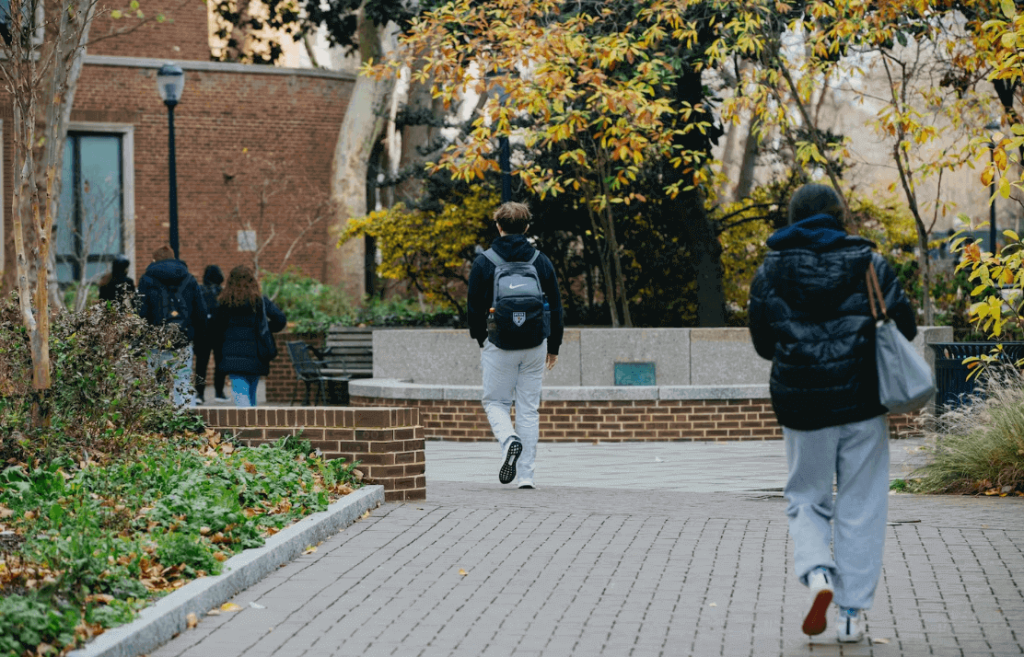【中美创新时报2024 年 10 月 24 日编译讯】(记者温友平编译)根据周三发布的一份新的全国报告,今年秋天,大学校园里的新生人数有所减少,但本科生总数连续第二年增加。《华盛顿邮报》记者Danielle Douglas-Gabriel 对此作了下述报道。
国家学生信息交换所研究中心对秋季入学情况的早期快照显示,今年秋季本科生人数比去年高出 3%,这得益于继续就读的学生和高中生抢先学习大学课程。这一数字仍比 2019 年秋季低 2.8%。
尽管有所增长,但根据 Clearinghouse 的数据,高等教育各个领域各年龄段的新生总数下降了 5%,这是自 2020 年疫情爆发以来的首次下降,当时下降了近 10%。高校报告称,今年秋季报名上课的 18 岁新生人数下降了近 6%。
初步数据是首次对入学趋势进行重要观察,此前一年,高等教育遭遇了平权行动的失败和新的联邦学生资助免费申请的灾难性推出。许多行业专家担心这些事态发展会对入学产生寒蝉效应,而新生人数的大幅下降可能证明他们是正确的。但分析师表示,很难确定下降的确切原因。
“很难确定造成这些变化的任何单一原因,尤其是今年秋季的新生,”该研究中心的执行主任道格·夏皮罗 (Doug Shapiro) 周二在与记者的电话会议上表示。“有很多不同的不利因素”,包括“人口下降……对大学费用和劳动力市场变化的持续担忧。”
不过,数据中的一些趋势可能反映了学生在获得经济援助方面面临的挑战。社区学院为大量符合佩尔助学金条件的学生提供服务——该助学金是为有特殊经济需求的本科生提供的援助——新生入学率增长了 1.2%,而佩尔助学金学生比例相似的四年制公立学院的新生入学率下降了 10% 以上。这可能意味着一些准备进入四年制大学的学生选择了学费较低的社区大学,尽管夏皮罗表示很难确定。
总体而言,四年制公立和私立非营利机构的新生人数下降幅度最大,分别下降了 8.5% 和 6.5%。
白人学生的新生入学率下降幅度最大,下降了 11.4%,而大学报告称黑人和多种族学生的入学率下降了 6% 以上。报告称,新生人数的下降影响到了各个收入阶层,来自中等收入社区的学生在四年制公立和私立非营利机构的入学率下降幅度最大。
教育部周三发布的新数据驳斥了 FAFSA(数十亿美元助学金和贷款的门户)的延迟和故障将导致入学率急剧下降的预测。
数据显示,与去年同期相比,今年有 3% 的学生有望获得联邦援助,而不是被剥夺大学资金。该部门表示,有 10% 的人有望获得佩尔助学金,其中包括 3% 的高中毕业生。联邦机构预计,今年将有更多的学生获得联邦财政援助进入大学,而不是上一学年。
教育部副部长詹姆斯·克瓦尔在周二讨论新发现的博客文章中写道:“我们感谢所有帮助学生度过艰难一年的大学辅导员、助学金管理人员、倡导者和其他合作伙伴,并认识到仍有工作要做,才能惠及每一位需要助学金的学生。”
与去年同期相比,该部门收到的 FAFSA 申请减少了 2%,高中毕业生和其他首次申请者之间的差距很大。该联邦机构表示,信息中心跟踪的新生人数下降可能归因于本科生入学人数持续下降的趋势,这种趋势在疫情爆发前就已很明显,劳动力市场强劲,或上大学的男性人数减少等人口因素。
根据前几年的情况,该部门表示,一旦信息中心今年冬天公布最终数据,新生入学前景可能会更好。该研究中心去年 10 月公布的初步数据确实显示新生人数有所下降,而最终数据则略有增加。
约有 52% 的学院和大学(代表近 900 万名学生)向信息中心报告了他们的入学情况,信息中心预计将在 1 月份公布更多学校的最终数据。
信息中心报告是备受关注的行业趋势指标。初步数据中的其他一些重要发现包括,拉丁裔、黑人、亚裔和多种族学生的本科和研究生入学人数强劲增长,而白人学生的本科入学人数持续下降。研究人员还指出,攻读短期证书的学生人数持续增长,本科证书课程的入学人数增长了 7.3%。
题图:去年,费城宾夕法尼亚大学校园里的学生。根据一份新报告,全国高校的本科生入学率下降,这是自 2020 年疫情爆发以来的首次。Michelle Gustafson/Bloomberg
附原英文报道:
Colleges enrolled fewer freshmen, first decline since the pandemic
By Danielle Douglas-Gabriel Washington Post,Updated October 23, 2024
Students on the University of Pennsylvania campus in Philadelphia last year. According to a new report, undergraduate enrollment at colleges and universities across the nation has declined, the first since the start of the pandemic in 2020.Michelle Gustafson/Bloomberg
Fewer freshmen showed up on college campuses this fall, according to a new national report released Wednesday, yet the overall number of undergraduates is up for the second year in a row.
An early snapshot of fall enrollment from the National Student Clearinghouse Research Center shows undergraduate head count this fall is 3 percent higher than last year, fueled by continuing students and high-schoolers getting a jump on college courses. That figure is still 2.8 percent below what it was in the fall of 2019.
Despite that growth, the total freshman head count of all ages across all segments of higher education was down 5 percent, the first decline since the start of the pandemic in 2020, when it plunged nearly 10 percent, according to Clearinghouse data. Colleges and universities reported an almost 6 percent drop in 18-year-old freshmen signing up for classes this fall.
The preliminary data is the first significant look at enrollment trends following a year in which higher education suffered the defeat of affirmative action and a disastrous rollout of the new Free Application for Federal Student Aid. Many industry experts feared those developments would have a chilling effect on enrollment, and the significant drop in freshmen might prove them right. But analysts said it’s difficult to assign a definitive reason for the decline.
“It’s very hard to pinpoint any single cause of the changes, particularly in freshmen this fall,” Doug Shapiro, the research center’s executive director, said on a call with reporters Tuesday. “There have been so many different headwinds,” including “demographic declines … continuing concerns about the cost of college and labor market shifts.”
Still, some trends in the data may reflect the challenges students have faced in securing financial aid. Community colleges that serve a high percentage of students eligible for the Pell Grant — aid for undergraduates with exceptional financial need — recorded a 1.2 percent increase in freshman enrollment, while four-year public colleges with a similar percentage of Pell Grant students reported a decline of more than 10 percent in freshman enrollment. That could mean some students who were bound for four-year institutions chose lower-cost community colleges, though Shapiro said it is difficult to know for certain.
Overall, four-year public and private nonprofit institutions reported the largest declines in freshmen, down 8.5 percent and 6.5 percent, respectively.
White students posted the largest drop in freshman enrollment, down 11.4 percent, while colleges and universities reported a more than 6 percent decline among Black and multiracial students. The decline in freshmen was felt across the earning spectrum, with students from middle-income neighborhoods seeing the largest drops at four-year public and private nonprofit institutions, according to the report.
New data released Wednesday by the Education Department refutes predictions that the delays and glitches in the FAFSA — the gateway to billions of dollars in grants and loans — would lead to a nosedive in enrollment.
Instead of being deprived of funding for college, the data shows that 3 percent more students are poised to receive federal aid this year compared with this time last year. Ten percent more are on track to receive Pell Grants, including 3 percent more high school seniors, according to the department. The federal agency expects more students to enroll in college with federal financial aid this academic year than the last one.
“We are thankful for all the college counselors, financial aid administrators, advocates, and other partners who helped students through a difficult year and recognize that there is still work to do to reach every student who needs financial aid,” Education Department Undersecretary James Kvaal wrote in a blog post discussing the new findings Tuesday.
Compared with this time last year, the department has received 2 percent fewer FAFSA submissions, with a large gap for high school seniors and other first-time filers. The federal agency said the decline in freshmen tracked by the Clearinghouse could be attributed to a continued downward trend in undergraduate enrollment that was evident before the pandemic, the strong labor market, or demographic factors like fewer men heading to college.
Based on prior years, the department said the outlook for freshman enrollment could be better once the Clearinghouse releases its final numbers this winter. Preliminary numbers released by the research center last October did show a decline in freshmen while final numbers registered a nominal increase.
About 52 percent of colleges and universities, representing nearly 9 million students, have reported their enrollment to the Clearinghouse, which expects to release final numbers from more schools in January.
The Clearinghouse report is a closely watched indicator of sector-wide trends. Among some of the other key findings in the preliminary data is strong growth in undergraduate and graduate enrollment for Latino, Black, Asian, and multiracial students, and a continued decline in undergraduate enrollment of white students. Researchers also noted the number of students pursuing shorter-term credentials continues to grow, with enrollment in undergraduate certificate programs up by 7.3 percent.

